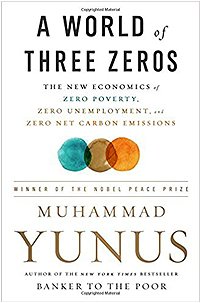Professor Yunus Visits the Lawrenceville School to deliver a speech at its Bicentennial Chapel Talks
The School concluded its year-long series of Bicentennial Chapel Talks this morning in distinguished fashion with honored guest Muhammad Yunus P’95, father of Monica Yunus ’95 and winner of the 2006 Nobel Peace Prize. In introducing her father, Monica also had the pleasure of announcing that the United States Congress yesterday voted unanimously to award him the Congressional Gold Medal, one of the nation’s highest civilian awards. Dr. Yunus was nominated for the Gold Medal by New Jersey Congressman Rush Holt, who attended the Chapel Talk.
Already a recipient of the Presidential Medal of Freedom and more than 30 honorary degrees from universities around the world, Professor Yunus is the founder of Grameen Bank and a pioneer in using “microcredit†to promote economic and social development. Microcredit, according to the website www.grameen-info.org, “is the extension of small loans to entrepreneurs too poor to qualify for traditional bank loans.†Grameen Bank makes loans without collateral to the poorest of the poor, seeking to break the cycle of poverty by financing even the smallest and most basic enterprises. The success of its mission is evident in the growth of ventures it has funded, some of which now make up the Grameen Network of companies and include telecommunications, software, internet, textile, energy and financial firms.
and financial firms.
The story of the birth of Grameen Bank and the development of the Grameen Network made for a fascinating David and Goliath tale. As a professor of economics at the University of Chittagong in Bangladesh, Dr. Yunus would daily venture into the nearby village of Jobra hoping he might think of a way to help the poor. Realizing that a centuries-old tradition of loansharking had helped to perpetuate the cycle of poverty in Jobra and other villages like it, he saw an opportunity to remedy the situation. Dr. Yunus compiled a list of 42 people in the village who needed loans – totaling the equivalent of $27 – and made the loans from his own pocket.
Overwhelmed by the subsequent demand, he tried repeatedly, without success, to bring a local bank into the picture. Finally, he agreed to personally guarantee loans to the poor, but eventually the response was so great the bank grew nervous about the amount it was lending, despite a nearly 100 percent repayment rate. It took another three years, but in 1983 Grameen Bank (Grameen means “village†in Bengali) was born.
Today, Grameen Bank has 8.3 million borrowers in Bangladesh, 97 percent of whom are women. Grameen lends more than $100 million each month, or more than $1 billion a year. The borrowers own the bank as its shareholders, and the loan repayment rate has never dipped below 97 percent.
“We do just the opposite of the big banks,†said Dr. Yunus. “They go to the rich; we go to the poor. They go to men; we go to women. They go to people in the cities; we go to people in the villages. They make people come to them; we go to the people who need us. We’re not just lending to the poor – we turned the banking concept upside down.†He used the example of the recent banking crisis to point out, “The big banks failed. Grameen Bank flourished.â€
In 2008 Grameen America was established in Queens, New York. “We chose New York because it is the capital of the banking world,†explained Dr. Yunus, “but people didn’t have access to the banking system. If (our model) works, we may succeed in changing that system.†Today, Grameen America has branches in four neighborhoods throughout New York City and a total of 4,000 borrowers – all women. The average loan is $1,500 and the repayment rate is 99.3 percent.
At each step along the way, Grameen Bank and the Grameen Network of businesses have grown to meet a need or solve a problem. Dr. Yunus described the bank’s insistence that borrowers’ children attend school and how that led to thousands of Grameen loans for higher education. A small cell-phone startup led by a few “telephone ladies†in a rural village has become the largest company in Bangladesh. The newest venture, Grameen Energy, is selling thousands of solar energy systems daily, and recently spawned a new company to produce solar panels. Additional joint ventures with established firms have introduced high-nutrition yogurt to Bangladesh in partnership with Dannon and inexpensive shoes for the poor in partnership with Adidas (exposure to parasitic diseases through bare feet is a major health issue in the developing world).
“Any one of us here can change the world,†Dr. Yunus submitted. “Just start with one problem and design a solution. If you can solve a problem for 10 people, it can work for 20 people, or 30.â€
Addressing the students, he said, “Through your grasp of technology, no generation before has had so much power at such a young age. You are a lucky generation.â€
Dr. Yunus’ latest book, Building Social Business, presents an innovative business model that proposes doing business to attack a social problem rather than to maximize profit. He writes, “Obtaining financing is probably one of the biggest hurdles you will have to f ace on the road to launching and running a successful social business. But with some creativity, resourcefulness, and a lot of patience, you should be able to achieve your goals.â€
Dr. Yunus obviously knows a lot about that last part, and he’s taught it to his daughter as well. Read about Monica’s organization, Sing for Hope, then check out Monica, who just happens to be a Metropolitan Opera soprano, on YouTube.
It should be mentioned that one of the early highlights of this final Chapel Talk was Monica’s shout out to Kirby House, where she lived as an underformer and served as a prefect. All Lawrentians are invited to reconnect with their Crescent or Circle House on October 8 when the Bicentennial House Parade will help kick off Lawrenceville’s two-day Bicentennial Celebration. Click here for more details on the House Parade and other Bicentennial events.
Source: http//www2.lawrenceville.org/podium/default.aspx?t=204&nid=545604


